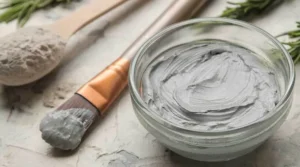Table of Contents
What is Kaolin Clay?
Historically, kaolin clay was first mined from the Kao-ling hill in China, which is how it got its name. Today, it is sourced globally, including in the United States, Brazil, Pakistan, and Bulgaria. It forms in hot, humid climates, such as rainforests, and contains minerals like silica, quartz, feldspar, copper, selenium, manganese, magnesium, and zinc.
While kaolin clay is not typically consumed for its nutrient content, it is widely used in skincare, pottery, ceramics, and even industrial products like toothpaste, cosmetics, and paper.

Kaolin Clay: Benefits, Uses, and Comparison with Bentonite Clay
Types of Kaolin Clay
Kaolin clay comes in various colors, each with unique properties:
- White Kaolin Clay: The most common type, ideal for sensitive and dry skin due to its gentle nature.
- Red Kaolin Clay: Rich in iron oxide, it is best for anti-aging and improving skin elasticity.
- Green Kaolin Clay: Contains plant matter and iron oxide, making it suitable for oily and acne-prone skin.
Benefits of Kaolin Clay
1. Gentle and Non-Irritating for Sensitive Skin
Kaolin clay is one of the mildest clays available, making it perfect for all skin types, including sensitive skin. Its pH level is close to that of human skin, reducing the risk of irritation. It is commonly used in facial masks and scrubs to cleanse, exfoliate, and improve skin texture.
2. Helps Manage Acne and Inflammation
Kaolin clay has natural antibacterial properties that help combat acne-causing bacteria. It absorbs excess oil and impurities from the skin, preventing blackheads and breakouts. Additionally, it soothes redness and inflammation, making it a great choice for acne-prone skin.
3. Reduces Signs of Aging
Rich in minerals like iron, kaolin clay can improve skin elasticity and firmness. It removes dead skin cells, evens out skin tone, and reduces the appearance of fine lines and wrinkles. Red kaolin clay, in particular, is known for its anti-aging benefits.
4. Supports Digestive Health
Kaolin pectin, a combination of kaolin and pectin fiber, is used to treat diarrhea and stomach ulcers. It works by binding to bacteria and toxins in the digestive tract. A 2018 study found it effective in reducing diarrhea symptoms.
5. Promotes Blood Clotting
Certain types of kaolin clay are used in medical settings to accelerate blood clotting and stop bleeding. For example, the U.S. Naval Medical Research Institute uses kaolin-infused gauze to treat wounds.
How to Use Kaolin Clay
Kaolin clay can be used in various ways, depending on your needs:
1. DIY Face Mask
Mix kaolin clay with water to form a paste. Apply it to damp skin, leave it on for 5-10 minutes, and rinse with warm water. This helps cleanse, exfoliate, and refresh your skin.
2. Detox Bath
Add 2 pounds of kaolin clay and 2 pounds of Epsom salt to a warm bath. You can also add essential oils like lavender for relaxation and additional skincare benefits.
3. Hair Treatment
Create a paste with kaolin clay and apply it to your scalp and roots. Leave it on for 5 minutes before rinsing and conditioning your hair. This helps cleanse the scalp without drying out your hair.
4. Teeth Whitening
Add a small amount of kaolin clay to your toothpaste to help remove plaque and whiten teeth. Be sure not to swallow the clay and rinse thoroughly afterward.
5. Internal Use for Diarrhea
Kaolin pectin can be taken orally to treat diarrhea. The recommended dose is 4-8 spoonfuls (60-120 ml) after each loose bowel movement. Always consult a healthcare professional before internal use.
Kaolin Clay vs. Bentonite Clay
Both kaolin and bentonite clays are popular in skincare, but they have key differences:
- pH Level: Kaolin clay has a lower pH, making it gentler and less drying than bentonite clay.
- Absorption: Bentonite clay absorbs more water, making it better for oily skin, while kaolin clay is ideal for sensitive or dry skin.
- Uses: Kaolin clay is versatile and suitable for skincare, haircare, and internal use, whereas bentonite clay is primarily used for detoxification and oily skin treatments.
Risks and Side Effects
Kaolin clay is generally safe for topical use, but there are some precautions to keep in mind:
- Avoid getting kaolin powder in your eyes or applying it to open wounds.
- If you have a history of allergic reactions to clays or silica products, avoid using kaolin clay.
- For internal use, consult a healthcare professional to avoid potential side effects like constipation or interactions with medications.
- Inhaling kaolin powder in large amounts can be harmful. The U.S. Occupational Safety and Health Administration (OSHA) recommends a safe exposure limit of 15 mg/m³ over an 8-hour workday.
Conclusion
Kaolin clay is a versatile and gentle clay with numerous benefits for skincare, haircare, and even digestive health. Its mild nature makes it suitable for sensitive skin, while its mineral content helps improve skin texture, reduce acne, and combat signs of aging. Compared to bentonite clay, kaolin clay is less drying and more versatile, making it a great addition to your natural health and beauty routine.
Always use kaolin clay responsibly, and consult a healthcare professional before internal use or if you have any concerns about potential side effects.